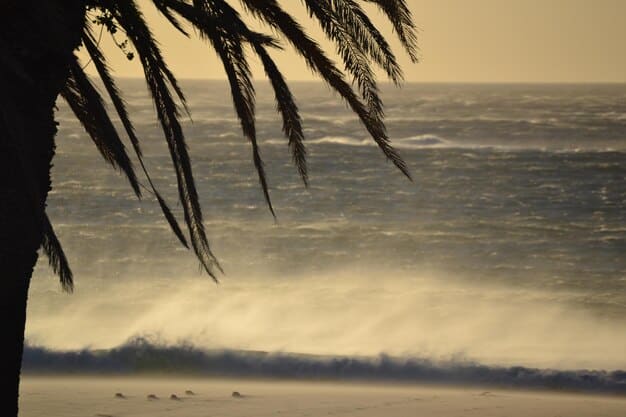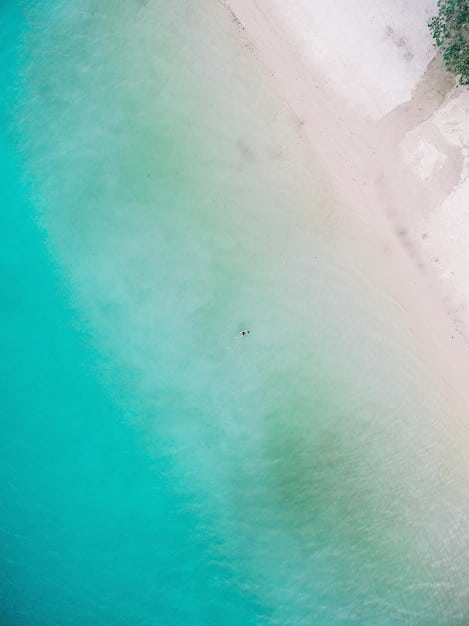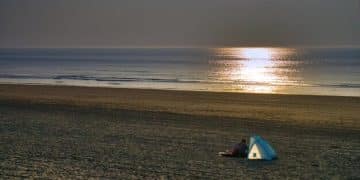Beach Relaxation: Mindfulness for Stress Relief

Achieving profound relaxation at the beach involves integrating mindfulness techniques to reduce stress, enhance presence, and foster inner peace amidst the soothing coastal environment, transcending mere physical presence into a state of mental well-being.
The allure of the ocean, with its rhythmic waves and boundless horizon, has long been a sanctuary for those seeking solace. But what if you could transcend mere escapism and truly harness the calming power of the seaside? This guide delves into Mastering the Art of Beach Relaxation: Mindfulness Techniques for Stress Relief, transforming a simple beach trip into a profound journey of self-discovery and tranquility.
The Science of Serenity: Why the Beach Calms Us
Humans possess an innate connection to nature, a concept often termed biophilia. This deep-seated affinity for living systems and natural environments explains why places like beaches exert such a powerful calming influence on our minds and bodies. From the vast expanse of the ocean to the rhythmic sound of the waves, every element conspires to reduce stress and promote a sense of well-being.
The science behind this calm is fascinating. Studies have shown that exposure to “blue space”—areas dominated by water—can significantly lower heart rates and blood pressure. The repetitive, predictable sound of ocean waves, known as pink noise, has a unique acoustic signature that promotes relaxation and can even improve sleep quality. This natural aural backdrop acts as a gentle, non-invasive form of therapy, quieting the constant chatter of our minds and allowing us to decompress. Moreover, the presence of negative ions in coastal air, generated by crashing waves, is believed to improve mood and alleviate symptoms of seasonal affective disorder (SAD), creating a subtly invigorating yet calming atmosphere.
The Cognitive Benefits of Coastal Environments
Beyond the physiological responses, beach environments offer profound cognitive benefits. The sheer vastness of the ocean encourages a sense of perspective, dwarfing daily worries and shifting our focus to grander scales. This shift can be liberating, fostering a feeling of humility and interconnectedness. Additionally, the natural light at the beach helps synchronize our circadian rhythms, promoting better sleep patterns, which in turn enhances overall mood and cognitive function. The absence of urban noise and the presence of natural stimuli allow for what researchers call “soft fascination,” a type of effortless attention that restores cognitive capacity without demanding excessive mental energy, unlike the “directed attention” required in busy city environments.
Sensory Immersion and Stress Reduction
The beach is a symphony of sensory experiences, each contributing to stress relief. The feeling of warm sand between our toes provides grounding and tactile stimulation. The gentle caress of the sea breeze on our skin offers a refreshing sensation. The scent of saltwater and the distinct aroma of marine life create an olfactory experience that triggers pleasant memories and fosters a deeper connection to the environment. These multi-sensory inputs work in concert to draw us out of our thoughts and into the present moment, a fundamental aspect of mindfulness. When our senses are fully engaged with the natural world, there is less room for rumination and anxiety.
Ultimately, the beach acts as a restorative sanctuary, a place where the intricate balance of natural elements aligns to create an optimal environment for physical and mental rejuvenation. Understanding these underlying mechanisms deepens our appreciation for this unique setting and empowers us to intentionally engage with its calming properties.
Preparation for Peace: Setting the Stage for Your Beach Retreat
True relaxation at the beach isn’t just about showing up; it’s about intentional preparation. Creating the right environment, both externally and internally, is crucial for maximizing your experience and allowing mindfulness techniques to flourish. This involves a few practical steps that set the stage for profound stress relief.
Essential Comfort Items for Optimal Relaxation
Your physical comfort is paramount. Pack a large, soft beach towel or a lightweight mat that allows you to stretch out fully. A comfortable beach chair, if you prefer not to lie directly on the sand, can make a significant difference. Don’t forget sun protection: a wide-brimmed hat, SPF 30+ sunscreen, and sunglasses are non-negotiable for prolonged exposure. Hydration is also key; bring a reusable water bottle filled with refreshing cold water to avoid dehydration, which can hinder relaxation. Small comforts like a light beach cover-up or a cozy throw can enhance your feeling of safety and warmth as the day progresses or if a cool breeze picks up.
Minimizing Distractions and Digital Detox
One of the biggest obstacles to true relaxation in our modern world is constant digital distraction. Consider leaving your smartphone in your bag, or better yet, at your accommodation. If you must bring it, set it to airplane mode or silent. The goal is to disconnect from the demands of notifications and social media, allowing your mind to fully engage with the present moment. Inform friends and family that you’ll be largely offline. This deliberate detachment signals to your brain that it’s time to unwind. Instead of scrolling, consider bringing a good book or a journal, activities that encourage contemplation rather than quick consumption.
Your journey towards beach tranquility begins before your toes even touch the sand. By thoughtfully curating your physical environment and consciously disconnecting from digital noise, you create a dedicated space for your mind to unfurl and embrace the calming embrace of the ocean. This preparation acts as a mindful transition, signaling to your system that it is entering a zone of peace.

Mindful Movement: Connecting Body and Breath by the Sea
The beach offers a unique and expansive setting for mindful movement, an accessible practice that grounds you in the present moment by synchronizing breath with physical activity. Whether it’s a brisk walk or gentle stretching, incorporating conscious movement enhances relaxation and invigorates the spirit.
Walking Meditation: Pacing with the Waves
Walking meditation is a simple yet profound practice. As you stroll along the shoreline, align your steps with the rhythm of the incoming and receding waves. Feel the sand beneath your feet, noticing its texture, temperature, and how it shifts with each step. Pay attention to the sensation of the breeze on your skin and the warmth of the sun. Allow your gaze to soften, taking in the vast horizon without focusing on any single point. This mindful walking transforms a simple stroll into a contemplative exercise, quietening mental chatter and centering your awareness on the immediate physical experience. Each breath can be linked to a step, or to the movement of the tide.
Gentle Yoga or Stretching with Ocean Views
For those inclined, the open space of the beach is ideal for gentle yoga or stretching. Find a secluded spot where you can comfortably lay down a towel. Begin with simple stretches, inhaling as you extend and exhaling as you release, mirroring the natural ebb and flow of the ocean. Yoga poses like “Mountain Pose” (Tadasana) can be performed standing, rooting you to the earth while allowing your chest to open to the vastness of the sea. “Child’s Pose” (Balasana) offers a moment of introspection and rest, feeling the sand beneath you. The key is not perfection of form, but rather the conscious engagement with your body and breath within this inspiring environment.
* Breath awareness: Pay attention to the sensation of each inhale and exhale. Notice how the salty air feels as it fills your lungs.
* Sensory focus: Engage all your senses. Listen to the ocean, feel the sun, observe distant seabirds.
* Non-judgmental observation: If your mind wanders, gently bring your attention back to your breath or the physical sensations of movement, without self-criticism.
* Mind-body connection: Recognize that your body and mind are interconnected, and movement can be a pathway to mental stillness.
Mindful movement at the beach offers a dynamic way to release physical tension and mental stress. By intentionally engaging your body and breath amidst the natural elements, you deepen your connection to the present moment, fostering a profound sense of peace and inner harmony that lasts long after your footprints have been washed away by the tide.
Sensory Immersion: The Five Senses of Beach Mindfulness
The beach is a kaleidoscope of sensations, presenting a perfect opportunity to practice mindfulness through sensory immersion. By consciously engaging each of your five senses, you can deepen your connection to the present moment and elevate your relaxation experience beyond the ordinary.
Sound: The Symphony of the Sea
The most iconic sound of the beach is the rhythmic crash of waves. Take a moment to truly listen. Distinguish between the gentle lapping nearer the shore and the more powerful roar of distant breakers. Can you hear the subtle hiss as the water recedes, dragging pebbles and sand? Beyond the waves, listen for the cries of seagulls, the rustle of the wind through coastal vegetation, or the occasional distant boat horn. Let these sounds wash over you, acknowledging them without judgment, allowing them to anchor your attention in the now. This auditory focus naturally quiets internal dialogue.
Sight: The Horizon’s Expansive View
Shift your gaze to the vastness of the horizon. Observe the subtle shifts in color in the sky and water. Notice the movement of clouds, the sparkle of sunlight on the waves, or the graceful flight of a bird. Allow your eyes to soften, taking in the grand perspective rather than focusing on small details. This broad, unfocused gaze can be incredibly calming, promoting a sense of spaciousness in your mind, contrasting with the narrow focus often demanded by daily life. Acknowledge any intriguing patterns in the sand or the vibrant colors of shells.
Touch: The Feel of Sand and Water
Engage your sense of touch. Bury your toes in the warm, dry sand, feeling its granular texture. Then, venture to the water’s edge and let the cool, refreshing waves wash over your feet. Notice the contrast in temperatures. Pick up a smooth, cool pebble or a rough, textured shell and feel its unique shape and surface. Allow the gentle breeze to caress your skin, perhaps feeling the warmth of the sun on your face. These tactile experiences ground you in physical reality, dispelling abstract worries.
Smell: The Aroma of the Ocean
Inhale deeply, drawing in the distinct scent of the ocean. It’s an earthy, saline aroma, often carrying a hint of iodine or dampness. Some describe it as fresh and invigorating. Allow this unique scent to fill your nostrils, consciously recognizing its presence without trying to analyze it. This olfactory engagement can evoke memories or simply deepen your connection to the natural environment, further enhancing a feeling of peace and contentment. It’s a primal scent that signals relaxation for many.
Taste: A Hint of Salt on the Air
While less direct than the other senses, the taste of the beach is subtly present. You might detect a faint, briny taste on your lips as the sea spray settles. If you bring a light, refreshing snack, engage your sense of taste mindfully. Savor each bite, noticing the flavors, textures, and how the food feels in your mouth. Even the taste of fresh water can be enhanced by the salty air, creating a holistic sensory experience.
By intentionally engaging each of your senses at the beach, you create a powerful anchor to the present moment. This practice of sensory immersion moves you beyond intellectual understanding and into embodied experience, allowing the beach to truly become a conduit for deep relaxation and stress relief.

Beyond the Senses: Cultivating Inner Peace at High Tide
While sensory immersion is a powerful gateway to beach relaxation, true mastery involves cultivating deeper states of inner peace. This transitions from simply engaging with the external environment to fostering internal states of calm and acceptance, even amidst the occasional external distraction.
Body Scan Meditation: From Toes to Horizon
Find a comfortable position, lying on your back or sitting upright. Close your eyes or keep a soft gaze forward. Begin by bringing your awareness to your toes, noticing any sensations there—warmth, coolness, tingling. Slowly move your attention up through your feet, ankles, calves, knees, and so on, moving methodically through every part of your body up to the crown of your head. As you focus on each area, simply observe without judgment. If you notice tension, gently breathe into it, inviting it to soften. This practice grounds you in your physical self, releasing stored tension and bringing a profound sense of embodiment.
Affirmations for Tranquility and Letting Go
Positive affirmations can reinforce a state of peace. While at the beach, gently repeat phrases that resonate with your desire for calm. For example: “I am at peace here and now.” “I release all tension with each wave that recedes.” “The ocean reminds me of my inner strength and vastness.” These statements, repeated with intention, can reprogram your subconscious, fostering a mindset of serenity and acceptance. Choose affirmations that feel authentic and empowering to you.
* Affirmation 1: “I am fully present in this moment, embraced by the sea’s tranquility.”
* Affirmation 2: “With every breath, I release what no longer serves me and invite calm.”
* Affirmation 3: “The power of the ocean reminds me of my own inner resilience and peace.”
* Affirmation 4: “I am worthy of this rest, and I allow myself to simply be.”
Connecting with Nature’s Rhythms: Ebb and Flow as Metaphor
Observe the ocean’s natural rhythm of ebb and flow. The waves come in, they recede; they never rush, never force. This natural cycle offers a profound metaphor for life’s challenges and your own emotional states. When a difficult thought arises, imagine it as a wave coming in, then let it gently recede, without clinging to it. Embrace the idea that just as the tide always turns, so too will any momentary discomfort or anxiety pass. This perspective can cultivate patience, acceptance, and a deep sense of connection to the natural world’s inherent wisdom. It teaches us to release control and trust the natural unfolding of events.
By integrating these deeper mindfulness practices, your beach experience transforms from a passive escape into an active cultivation of inner peace. You learn to harness the beach’s external tranquility as a mirror for your own burgeoning inner calm, creating a lasting reservoir of peace within your being.
Troubleshooting Relaxation: Overcoming Common Beach Hurdles
Even with the best intentions, a beach trip can present unexpected challenges that threaten to derail your quest for relaxation. From noisy crowds to overthinking, knowing how to navigate these common hurdles ensures your mindful experience remains intact.
Dealing with Crowds and Noise
A bustling beach can feel overwhelming. If possible, arrive early in the morning or later in the afternoon when crowds tend to thin out. Seek out less popular, quieter stretches of the beach. Noise-canceling headphones, playing calm music or nature sounds, can be your best friend. Alternatively, use the noise as a mindfulness practice itself: acknowledge the sounds without judgment, recognizing them as simply part of the present moment, then gently redirect your focus to the waves or your breath.
Managing External Distractions – Kids, Vendors, etc.
Children’s joyful shouts or persistent vendors can test your patience. If you have children with you, ensure they are happily engaged with their own activities, perhaps in a designated play area. For vendors, a polite but firm “no, thank you” is usually sufficient. Remember, you have control over your reactions. Instead of dwelling on the annoyance, shift your focus internally. This is an opportunity to practice non-reactivity and acceptance, allowing external events to unfold without disturbing your inner calm.
Successfully navigating these common beach hurdles transforms them into further opportunities for mindfulness. Each challenge overcome deepens your ability to cultivate inner peace, proving that true relaxation is not about the absence of external stimuli, but your ability to remain centered amidst them. It teaches resilience and adaptability in your mindfulness practice.
Integrating Beach Zen: Bringing Mindfulness Home
The profound relaxation experienced at the beach shouldn’t be confined to the shoreline. The true art of beach relaxation lies in the ability to carry its tranquility and mindfulness into your daily life, transforming your home environment and fostering lasting stress relief.
Creating a “Beach Corner” at Home
Designate a small space in your home as your “beach corner.” This doesn’t require a complete renovation. It could be a comfortable chair with ocean-themed decor, such as a blue throw, a collection of seashells, or a print of a serene beach scene. Introduce elements that evoke the senses of the beach: a diffuser with an ocean-scented essential oil, a sound machine playing wave sounds, or simply a jar of sand and shells collected from your trip. This visual and sensory reminder serves as an instant cue for relaxation, prompting your mind to recall the peaceful state you achieved at the seaside.
Daily Mindfulness Practices Inspired by the Ocean
Incorporate small daily rituals that echo your beach experience. Practice mindful breathing by visualizing the ebb and flow of the tide with each inhale and exhale. When stress starts to build, close your eyes and recall the feeling of sand between your toes or the sound of the waves. Take mindful walks in your neighborhood, paying attention to the sounds, sights, and smells around you, just as you would at the beach. Even a quick shower can become a mindful moment, focusing on the sensation of water on your skin, much like the ocean’s embrace.
Using Sensory Cues to Trigger Relaxation
Identify specific sensory cues from your beach trip that instantly trigger a feeling of calm. It could be the scent of a particular sunscreen, the sound of a specific piece of music you listened to, or even just a visual of a wave. Intentionally integrate these cues into your daily routine when you need a mindful pause. For instance, light an ocean-scented candle when you start your meditation, or listen to wave sounds during a brief work break. These sensory anchors serve as powerful reminders, instantly transporting your mind back to that state of seaside serenity.
By consciously integrating these practices, the beach becomes more than just a vacation destination; it transforms into a wellspring of mindfulness that continuously nourishes your well-being. The art of beach relaxation truly blooms when its principles are interwoven into the fabric of your everyday life, making peace and tranquility an accessible, ongoing state.
| Key Takeaway | Brief Description |
|---|---|
| 🧘♀️ Mindful Presence | Engage senses to ground yourself in the beach environment, fostering deep presence and peace. |
| 🌬️ Breath & Movement | Synchronize breathing with gentle walks or yoga, enhancing physical and mental calm. |
| 🔌 Digital Detox | Minimize distractions to fully immerse in the experience, allowing for true mental escape. |
| 🏡 Bring Zen Home | Integrate beach-inspired practices and decor into daily life for ongoing tranquility. |
Frequently Asked Questions
▼
Mindfulness is the practice of being fully present in the moment, aware of your thoughts, feelings, bodily sensations, and surrounding environment without judgment. At the beach, it means consciously engaging your senses with the sand, waves, sun, and air, rather than letting your mind wander to daily stressors. This intentional presence deepens relaxation and stress relief.
▼
To minimize distractions at a crowded beach, try arriving early or late to avoid peak times. Seek out less frequented sections of the shore. Consider bringing noise-canceling headphones to block out external sounds, or simply practice acknowledging distractions without engagement, gently refocusing on your breath or the natural sounds of the ocean.
▼
Yes, deep belly breathing, also known as diaphragmatic breathing, is highly effective. Inhale slowly and deeply through your nose, allowing your belly to rise, then exhale slowly through your mouth, letting your belly fall. You can also try rhythmic breathing, counting to align your inhales and exhales with the rhythm of the waves, enhancing a sense of calm.
▼
To enhance your mindfulness practice, bring essentials for comfort like a large towel or mat, sun protection (hat, sunscreen), and plenty of water. Consider a journal to jot down reflections, and if comfortable, noise-canceling headphones. Most importantly, bring a willingness to disconnect from digital devices and fully immerse yourself in the natural beach environment.
▼
You can integrate beach mindfulness by creating a “beach corner” at home with sensory cues like ocean scents or sounds. Practice daily mindful breathing, visualizing waves, or take mindful walks outdoors. Use sensory triggers that remind you of the beach (e.g., specific music or scents) to anchor yourself in moments of calm when stress arises, maintaining a connection to that peaceful state.
Conclusion
Mastering the Art of Beach Relaxation: Mindfulness Techniques for Stress Relief is more than just a guide; it’s an invitation to transform your relationship with the seaside and, by extension, with your own well-being. By intentionally embracing the science behind nature’s calming power and actively engaging mindfulness practices, you can unlock a profound sense of peace that extends far beyond the duration of your trip. The beach, with its timeless rhythms and boundless serenity, offers a powerful classroom for presence, a sanctuary for stress relief, and a reminder of the restorative balm of connecting with the natural world. Implement these techniques, and discover a sustainable source of tranquility waiting for you, both at the shore and within.





